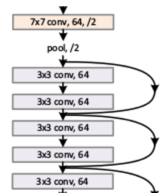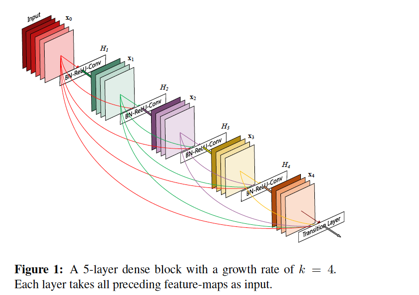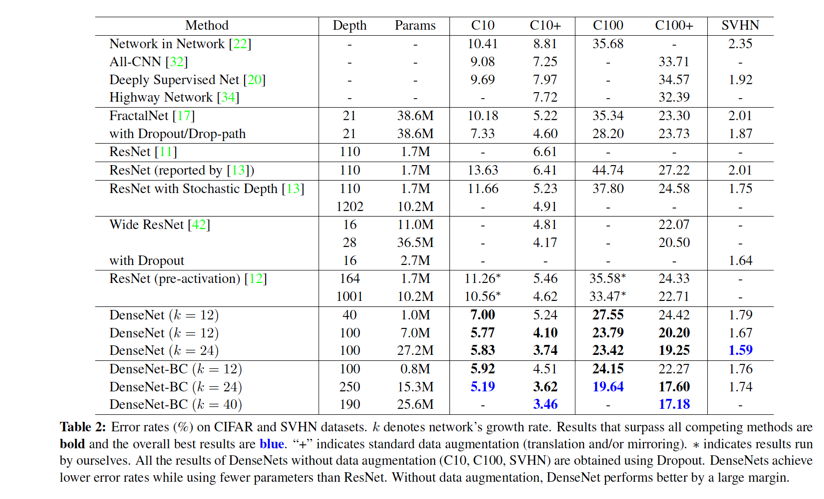
@[t oc]
1 简单介绍

论文题目:Densely Connected Convolutional Networks
发表机构:康奈尔大学,清华大学,Facebook AI
发表时间:2018年1月
论文代码:https://github.com/WangXiaoCao/attention-is-all-you-need-pytorch
pytorch代码:https://github.com/WangXiaoCao/attention-is-all-you-need-pytorch
1.1 背景介绍
1.卷积神经网络CNN在计算机视觉物体识别上优势显著,典型的模型有:LeNet5, VGG, Highway Network, Residual Network.
2.CNN越深则效果越好,但是,会面临梯度弥散的问题,经过层数越多,则前面的信息就会渐渐减弱和消散。
3.目前已有很多措施去解决以上困境:
(1)Highway Network,Residual Network通过前后两层的残差链接使信息尽量不丢失
(2)Stochastic depth通过随机drop掉Resnet的一些层来缩短模型
(3)FractalNets通过重复组合一些平行的层序列来保证深度的同时减轻这个问题。
但这些措施都有一个共性:都是在前一层和后一层中都建立一个短连接。比如,酱紫:

1.2 本文概要
1.2.1 模型结构预览
本文提出的densenet就更霸道了,为了确保网络中最大的信息流通,让每层都与改层之前的所有层都相连,即每层的输入,是前面所有层的输出的concat.(resnet用的是sum).整体结构是酱紫的:

1.2.2 优点
1.需要更少参数。
2.使得信息(前向计算时)或梯度(后向计算时)在整个网络中的保持地更好,可以训练更深的模型。
3.dense connection有正则化的效果,在较少训练集上减少过拟合。

1.2.3 实验结果
在4个benchmark datasets (CIFAR-10, CIFAR-100, SVHN, and
ImageNet)上测试。
大部分任务上都优于state of art.
2 模型结构
2.1 整体结构

1.输入:图片
2.经过feature block(图中的第一个convolution层,后面可以加一个pooling层,这里没有画出来)
3.经过第一个dense block, 该Block中有n个dense layer,灰色圆圈表示,每个dense layer都是dense connection,即每一层的输入都是前面所有层的输出的拼接
4.经过第一个transition block,由convolution和poolling组成
5.经过第二个dense block
6.经过第二个transition block
7.经过第三个dense block
8.经过classification block,由pooling,linear层组成,输出softmax的score
9.经过prediction层,softmax分类
10.输出:分类概率
作者在4个数据集上进行测试,CIFAR-10, CIFAR-100, SVHN上构建的是以上3个dense block + 2个transition block;在ImageNet上构建的是4个dense block + 3个transition block。两者在参数的设置上略有不同,下文将以ImageNet上构建的densenet为例进行讲解。
2.2 Feature Block
Feature Block是输入层与第一个Dense Block之间的那一部分,上面结构图中只画了一个卷积,在ImageNet数据集上构建的densenet中其实后面还跟了一个poolling层。计算过程如下:
输入:图片 (244 * 244 * 3)
1.卷积层convolution计算:in_channel=3, out_channel=64,kernel_size=7,stride=2,padding=3,输出(122 * 122 * 64)
2.batch normalization计算,输入与输出维度不变 (122 * 122 * 64)
3.激活函数relu计算,输入与输出维度不变 (122 * 122 * 64)
4.池化层poollig计算,kenel_size=3, stride=2,padding=1,输出(56 * 56 * 64)
from torch.nn import Sequential, Conv2d, BatchNorm2d, ReLU, MaxPool2d
class FeatureBlock(RichRepr, Sequential):
def __init__(self, in_channels, out_channels):
super(FeatureBlock, self).__init__()
self.in_channels = in_channels
self.out_channels = out_channels
# add_module:在现有model中增添子module
self.add_module('conv', Conv2d(in_channels, out_channels, kernel_size=7, stride=2, padding=3, bias=False)),
self.add_module('norm', BatchNorm2d(out_channels)),
self.add_module('relu', ReLU(inplace=True)),
self.add_module('pool', MaxPool2d(kernel_size=3, stride=2, padding=1)),
2.3 Dense Block 和 Dense Layer
2.3.1 Dense Layer
一个Dense Block中是由L层dense laryer组成,layer之间是dense connectivity。从下面这个公式上来体会什么是dense connectivity,第l层的输出是:

H_l是该layer的计算函数,输入是x0到x_l-1的拼接,即模型的原始输出(x0)和前面每层的输出的拼接。这个拼接是channel维度上的拼接,即维度(56 * 56 * 64)的数据 和(56 * 56 * 32)的数据拼接成(56 * 56 * 96)的数据维度。
而ResNet就不同了,是直接将前一层的输出加在该层的输出之上:

Dense Layer中函数H(·)的计算过程如下(括号中的数据维度是以第一个dense block的第一个dense layer为例的,整个模型的k值是预先设定的,本模型为k=32):
输入:Feature Block的输出(56 * 56 * 64)或者是上一层dense layer的输出
1.Batch Normalization, 输出(56 * 56 * 64)
2.ReLU ,输出(56 * 56 * 64)
3.Bottleneck,是可选的,为了减少 feature-maps的数量,过程如下3步
-1x1 Convolution, kernel_size=1, channel = 4k, 则输出为(56 * 56 * 128)
-Batch Normalization(56 * 56 * 128)
-ReLU(56 * 56 * 128)
4.Convolution, kernel_size=3, channel = k (56 * 56 * 32)
5.Dropout,可选的,用于防止过拟合(56 * 56 * 32)
from typing import Optional
from torch.nn import Sequential, BatchNorm2d, ReLU, Conv2d, Dropout2d
from .bottleneck import Bottleneck
class DenseLayer(RichRepr, Sequential):
r"""
Dense Layer as described in [DenseNet](https://arxiv.org/abs/1608.06993)
and implemented in https://github.com/liuzhuang13/DenseNet
Consists of:
- Batch Normalization
- ReLU
- (Bottleneck)
- 3x3 Convolution
- (Dropout)
"""
def __init__(self, in_channels: int, out_channels: int,
bottleneck_ratio: Optional[int] = None, dropout: float = 0.0):
super(DenseLayer, self).__init__()
self.in_channels = in_channels
self.out_channels = out_channels
self.add_module('norm', BatchNorm2d(num_features=in_channels))
self.add_module('relu', ReLU(inplace=True))
if bottleneck_ratio is not None:
self.add_module('bottleneck', Bottleneck(in_channels, bottleneck_ratio * out_channels))
in_channels = bottleneck_ratio * out_channels
self.add_module('conv', Conv2d(in_channels, out_channels, kernel_size=3, padding=1, bias=False))
if dropout > 0:
self.add_module('drop', Dropout2d(dropout, inplace=True))
Bottleneck代码如下:
from torch.nn import Sequential, Conv2d, BatchNorm2d, ReLU
from ..utils import RichRepr
class Bottleneck(RichRepr, Sequential):
r"""
A 1x1 convolutional layer, followed by Batch Normalization and ReLU
"""
def __init__(self, in_channels: int, out_channels: int):
super(Bottleneck, self).__init__()
self.in_channels = in_channels
self.out_channels = out_channels
self.add_module('conv', Conv2d(in_channels, out_channels, kernel_size=1, bias=False))
self.add_module('norm', BatchNorm2d(num_features=out_channels))
self.add_module('relu', ReLU(inplace=True))
2.3.2 Dense Block
Dense Block有L层dense layer组成
layer 0:输入(56 * 56 * 64)->输出(56 * 56 * 32)
layer 1:输入(56 * 56 (32 * 1))->输出(56 * 56 * 32)
layer 2:输入(56 * 56 (32 * 2))->输出(56 * 56 * 32)
…
layer L:输入(56 * 56 * (32 * L))->输出(56 * 56 * 32)
注意,L层dense layer的输出都是不变的,而每层的输入channel数是增加的,因为如上所述,每层的输入是前面所有层的拼接。
rom typing import Optional
import torch
from torch.nn import Module
from .dense_layer import DenseLayer
class DenseBlock(RichRepr, Module):
r"""
Dense Block as described in [DenseNet](https://arxiv.org/abs/1608.06993)
and implemented in https://github.com/liuzhuang13/DenseNet
- Consists of several DenseLayer (possibly using a Bottleneck and Dropout) with the same output shape
- The first DenseLayer is fed with the block input
- Each subsequent DenseLayer is fed with a tensor obtained by concatenating the input and the output
of the previous DenseLayer on the channel axis
- The block output is the concatenation of the output of every DenseLayer, and optionally the block input,
so it will have a channel depth of (growth_rate * num_layers) or (growth_rate * num_layers + in_channels)
"""
def __init__(self, in_channels: int, growth_rate: int, num_layers: int,
concat_input: bool = False, dense_layer_params: Optional[dict] = None):
super(DenseBlock, self).__init__()
self.concat_input = concat_input
self.in_channels = in_channels
self.growth_rate = growth_rate
self.num_layers = num_layers
self.out_channels = growth_rate * num_layers
if self.concat_input:
self.out_channels += self.in_channels
if dense_layer_params is None:
dense_layer_params = {}
for i in range(num_layers):
# 增添dense_layer:norm->relu->bottleneck->conv->dropout
self.add_module(
f'layer_{i}',
DenseLayer(in_channels=in_channels + i * growth_rate, out_channels=growth_rate, **dense_layer_params)
)
def forward(self, block_input):
layer_input = block_input
# empty tensor (not initialized) + shape=(0,)
layer_output = block_input.new_empty(0)
all_outputs = [block_input] if self.concat_input else []
for layer in self._modules.values():
layer_input = torch.cat([layer_input, layer_output], dim=1)
layer_output = layer(layer_input)
all_outputs.append(layer_output)
return torch.cat(all_outputs, dim=1)
2.4 Transition Block
Transition Block是在两个Dense Block之间的,由一个卷积+一个pooling组成(下面的数据维度以第一个transition block为例):
输入:Dense Block的输出(56 * 56 * 32)
1.Batch Normalization 输出(56 * 56 * 32)
2.ReLU 输出(56 * 56 * 32)
3.1x1 Convolution,kernel_size=1,此处可以根据预先设定的压缩系数(0-1之间)来压缩原来的channel数,以减小参数,输出(56 * 56 *(32 * compression))
4.2x2 Average Pooling 输出(28 * 28 * (32 * compression))
class Transition(RichRepr, Sequential):
r"""
Transition Block as described in [DenseNet](https://arxiv.org/abs/1608.06993)
and implemented in https://github.com/liuzhuang13/DenseNet
Consists of:
- Batch Normalization
- ReLU
- 1x1 Convolution (with optional compression of the number of channels)
- 2x2 Average Pooling
"""
def __init__(self, in_channels, compression: float = 1.0):
super(Transition, self).__init__()
if not 0.0 < compression <= 1.0:
raise ValueError(f'Compression must be in (0, 1] range, got {compression}')
self.in_channels = in_channels
# transition中可设置压缩系数,以减少输出channel
self.out_channels = int(ceil(compression * in_channels))
self.add_module('norm', BatchNorm2d(num_features=self.in_channels))
self.add_module('relu', ReLU(inplace=True))
self.add_module('conv', Conv2d(self.in_channels, self.out_channels, kernel_size=1, bias=False))
self.add_module('pool', AvgPool2d(kernel_size=2, stride=2))
2.5 循环Dense Block和Transition
论文中,在ImageNet的数据集上,构建的densenet是由4个Dense Block,和3个Transition构成,按照上文讲述的过程,数据流的演变过程应该是:
Dense Block1:输入(565664),输出(565632)
Transition1:输入(565632),输出(282832)
Dense Block2:输入(282832),输出(282832)
Transition2:输入(282832),输出(141432)
Dense Block3:输入(141432),输出(141432)
Transition3:输入(141432),输出(7732)
2.6 ClassificationBlock
最后一步是ClassificationBlock,这一步将原来3维的数据拉平成一维,再接上全连接层,以准备做softmax。计算过程如下:
输入:Transition3的输出(7 * 7 * 32)
1.Batch Normalization, 输出(7 * 7 * 32)
2.ReLU, 输出(7 * 7 * 32)
3.poolling, kernel_size=7, stride=1,输出(1 * 1 * 32)
4.flatten,将(1 * 1 * 32)铺平成(1 * 32)
5.Linear全连接,输出(1*classes_num) classes_num为待分类的数目
from torch.nn import Sequential, BatchNorm2d, ReLU, AvgPool2d, Linear
from ..shared import Flatten
class ClassificationBlock(RichRepr, Sequential):
r"""
Classification block for [DenseNet](https://arxiv.org/abs/1608.06993),
takes in a 7x7 feature map and outputs logit scores for classification
"""
def __init__(self, in_channels, output_classes):
super(ClassificationBlock, self).__init__()
self.in_channels = in_channels
self.out_classes = output_classes
self.add_module('norm', BatchNorm2d(num_features=in_channels))
self.add_module('relu', ReLU(inplace=True))
self.add_module('pool', AvgPool2d(kernel_size=7, stride=1))
self.add_module('flatten', Flatten())
self.add_module('linear', Linear(in_channels, output_classes))
flaten代码如下:
from torch.nn import Module
class Flatten(Module):
def forward(self, x):
return x.view(x.size(0), -1)
最后将以上输出进入softmax,预测每个类别的概率。
logits = self(x) //x是linear层的输出
return F.softmax(logits)
2.7 整合以上过程
将以上所有过程都这个起来,构建一个完整的densenet模型,代码如下:
from itertools import zip_longest
from typing import Sequence, Union, Optional
from torch.nn import Sequential, Conv2d, BatchNorm2d, Linear, init
from torch.nn import functional as F
from .classification_block import ClassificationBlock
from .feature_block import FeatureBlock
from .transition import Transition
from ..shared import DenseBlock
# 继承Sequential类
class DenseNet(Sequential):
def __init__(self,
in_channels: int = 3,
output_classes: int = 1000,
initial_num_features: int = 64,
dropout: float = 0.0,
dense_blocks_growth_rates: Union[int, Sequence[int]] = 32,
dense_blocks_bottleneck_ratios: Union[Optional[int], Sequence[Optional[int]]] = 4,
dense_blocks_num_layers: Union[int, Sequence[int]] = (6, 12, 24, 16),
transition_blocks_compression_factors: Union[float, Sequence[float]] = 0.5):
"""
构建完成densenet模型
:param in_channels: 输入的channel数目
:param output_classes: 待分类别树
:param initial_num_features: 进入第一个Block的feature map数目
:param dropout: dropout的比率
:param dense_blocks_growth_rates: k(block中的channel数)
:param dense_blocks_bottleneck_ratios: (bottleneck的比率)
:param dense_blocks_num_layers: densenet的block数目
:param transition_blocks_compression_factors: 在transition层中的压缩系数(0-1之间)
"""
super(DenseNet, self).__init__()
# region Parameters handling
self.in_channels = in_channels
self.output_classes = output_classes
# 扩展成4维:(10,10,10,10)
if type(dense_blocks_growth_rates) == int:
dense_blocks_growth_rates = (dense_blocks_growth_rates,) * 4
if dense_blocks_bottleneck_ratios is None or type(dense_blocks_bottleneck_ratios) == int:
dense_blocks_bottleneck_ratios = (dense_blocks_bottleneck_ratios,) * 4
if type(dense_blocks_num_layers) == int:
dense_blocks_num_layers = (dense_blocks_num_layers,) * 4
if type(transition_blocks_compression_factors) == float:
transition_blocks_compression_factors = (transition_blocks_compression_factors,) * 3
# endregion
# region First convolution
# 1.第一个卷积:covn->norm->relu->pool
features = FeatureBlock(in_channels, initial_num_features)
current_channels = features.out_channels
self.add_module('features', features)
# endregion
# region Dense Blocks and Transition layers
# Dense Blocks 参数
dense_blocks_params = [
{
'growth_rate': gr,
'num_layers': nl,
'dense_layer_params': {
'dropout': dropout,
'bottleneck_ratio': br
}
}
for gr, nl, br in zip(dense_blocks_growth_rates, dense_blocks_num_layers, dense_blocks_bottleneck_ratios)
]
# Transition layers 参数
transition_blocks_params = [
{
'compression': c
}
for c in transition_blocks_compression_factors
]
block_pairs_params = zip_longest(dense_blocks_params, transition_blocks_params)
for block_pair_idx, (dense_block_params, transition_block_params) in enumerate(block_pairs_params):
block = DenseBlock(current_channels, **dense_block_params)
current_channels = block.out_channels
# 增添DenseBlock:dense_block->dense_block->...dense_block
self.add_module(f'block_{block_pair_idx}', block)
if transition_block_params is not None:
transition = Transition(current_channels, **transition_block_params)
current_channels = transition.out_channels
# 增加transition:covn->norm->relu->pool
self.add_module(f'trans_{block_pair_idx}', transition)
# endregion
# region Classification block
# 添加最后的分类层:norm->relu->poll->flaten->linear
self.add_module('classification', ClassificationBlock(current_channels, output_classes))
# endregion
# region Weight initialization
for module in self.modules():
if isinstance(module, Conv2d):
init.kaiming_normal_(module.weight)
elif isinstance(module, BatchNorm2d):
module.reset_parameters()
elif isinstance(module, Linear):
init.xavier_uniform_(module.weight)
init.constant_(module.bias, 0)
# endregion
def predict(self, x):
logits = self(x)
return F.softmax(logits)
我们可以根据构建好的densenet模型,输入不同参数,得到自定义的densenet模型,论文中,作者分别尝试了如下深度的模型:
区别在于dense_blocks_num_layers的设置,也就是每个dense block中的dense layer的数目。
from .densenet import DenseNet
class DenseNet121(DenseNet):
def __init__(self, dropout: float = 0.0):
super(DenseNet121, self).__init__(
in_channels=3,
output_classes=1000,
initial_num_features=64,
dropout=dropout,
dense_blocks_growth_rates=32,
dense_blocks_bottleneck_ratios=4,
dense_blocks_num_layers=(6, 12, 24, 16),
transition_blocks_compression_factors=0.5
)
class DenseNet169(DenseNet):
def __init__(self, dropout: float = 0.0):
super(DenseNet169, self).__init__(
in_channels=3,
output_classes=1000,
initial_num_features=64,
dropout=dropout,
dense_blocks_growth_rates=32,
dense_blocks_bottleneck_ratios=4,
dense_blocks_num_layers=(6, 12, 32, 32),
transition_blocks_compression_factors=0.5
)
class DenseNet201(DenseNet):
def __init__(self, dropout: float = 0.0):
super(DenseNet201, self).__init__(
in_channels=3,
output_classes=1000,
initial_num_features=64,
dropout=dropout,
dense_blocks_growth_rates=32,
dense_blocks_bottleneck_ratios=4,
dense_blocks_num_layers=(6, 12, 48, 32),
transition_blocks_compression_factors=0.5
)
class DenseNet161(DenseNet):
def __init__(self, dropout: float = 0.0):
super(DenseNet161, self).__init__(
in_channels=3,
output_classes=1000,
initial_num_features=64,
dropout=dropout,
dense_blocks_growth_rates=48,
dense_blocks_bottleneck_ratios=4,
dense_blocks_num_layers=(6, 12, 36, 24),
transition_blocks_compression_factors=0.5
)
3 实验与结果
3.1 训练参数
| 参数 | CIFAR和SVHN数据集上 | ImageNet数据 |
|---|---|---|
| 优化方式 | 梯度下降 | 梯度下降 |
| batch size | 64 | 256 |
| epoch | 300for CIFAR40 forSVHN | 90 |
| learning rate | initial learning rate is set to 0.1, and is divided by 10 at 50% and 75% of the total number of training epochs | The learning rate is set to 0.1 initially, and is lowered by 10 times at epoch 30 and 60 |
| weight decay | 10^-4 | 10^-4 |
| Nesterov momentum | 0.9 | 0.9 |
| drop rate | 0.2 | 0.2 |
3.2 结果
在CIFAR和SVHN数据集上的结果:

在Imagenet上的结果:


文章代码来自:https://github.com/WangXiaoCao/attention-is-all-you-need-pytorch